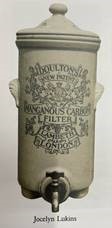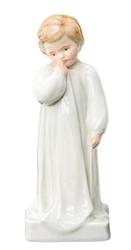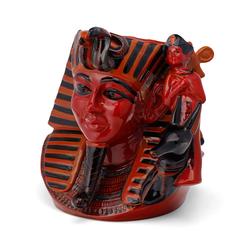Royal Doulton

The Royal Doulton story began in 1815, when John Doulton, aged 22, invested his life savings of £100.00 into a small riverside pottery in Lambeth, South London, together with Martha Jones and John Watts.
This pottery, one of many in the area, specialised in manufacturing a range of utilitarian salt-glazed stoneware. In 1835 Henry Doulton joined the firm and it flourished due to Henry's role in the 'sanitary revolution' - pioneering the general use of stoneware drainpipes and water filters to improve living conditions.
Henry Doulton was an innovator of his day, and he came up with several ingenious ways of engineering and manufacturing the pipes and other stoneware items that made Doulton & Watts world-class experts in the field. Their wares were exhibited at the Great Exhibition held in London's Hyde Park in 1851.
In 1860 the business diversified further after Henry offered work to designers and artists from the Lambeth School of Art. The first to be employed was George Tinworth followed by artists such as the Barlow family (Florence, Hannah and Arthur), Frank Butler, Mark Marshall and Eliza Simmance. This resulted in pieces that were the opposite of the industrial pieces as they were items that were delicately modelled, brightly coloured, exquisitely decorated and won the hearts of collectors all over the world.
In 1877 Doulton purchased the small factory of Pinder, Bourne & Co, at Nile Street in Burslem, Staffordshire, which placed Doulton in the region known as 'The Potteries.'
Queen Victoria was a notable fan and Henry Doulton was knighted by the queen in 1887 for his services to ceramics and the advancement of ceramic art. In 1901, four years after Henry's death, King Edward VII granted a Royal Warrant and the right to use 'Royal' in the name. The company was then known as Royal Doulton.

In 1913 CJ Noke launched his HN series just in time for a Royal visit. Queen Mary singled out a charming figurine by Charles Vyse and exclaimed 'Isn't he a Darling!' and he was immediately promoted to HN1 and renamed.

King George V & Queen Mary visit Royal Doulton

Royal Doulton Figurine Display admired by Queen Mary.
Royal Doulton captured the Queen's Awards for Industry, Technological Innovation and Outstanding Export Performance for its contribution to china manufacturing in 1966.
Royal Doulton pottery also made Flambe potterywhere “Flambe” refers to a distinctive glazing technique that results in
rich, vibrant colours, often with a varied, mottled appearance resembling flames, hence
the name. This originated in China - you can learn more by Clicking Here.
The very large, beautiful ceramic frieze depicting Pottery Through the Ages, was designed and modelled by the sculptor Gilbert Bayes for the facade of Doulton House in Lambeth. Manufacture of ceramics ceased at Lambeth in 1956 and in 1968 Royal Doulton moved their headquarters to Stoke-on-Trent. Doulton house was sold and remained empty until 1978 when a decision was made to demolish the building. Volunteers from Ironbridge Gorge Museum rescued the frieze which was taken to Ironbridge for storage. The frieze was installed in the Victoria & Albert Museum in 1988.






